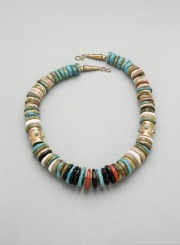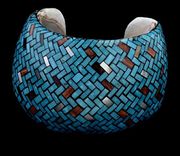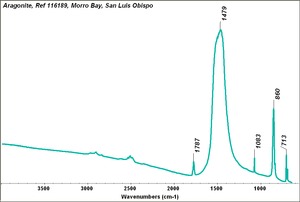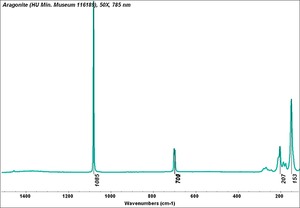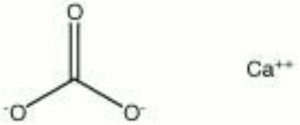Difference between revisions of "Oyster shell"
Jump to navigation
Jump to search
(username removed) |
|||
| (6 intermediate revisions by 3 users not shown) | |||
| Line 1: | Line 1: | ||
| − | [[File:1985.457-SC62344.jpg|thumb|]] | + | [[File:1985.457-SC62344.jpg|thumb|Native American necklace<br>MFA# 1985.457]] |
== Description == | == Description == | ||
| − | Shells from any marine mollusk of the family ''Ostreidae''. Edible mollusks, such as the ''Ostrea virginica'', found in the Gulf of Mexico and the Chesapeake Bay, account for most of the shells currently produced. Pearl white, a white, [ | + | Shells from any marine mollusk of the family ''Ostreidae''. Edible mollusks, such as the ''Ostrea virginica'', found in the Gulf of Mexico and the Chesapeake Bay, account for most of the shells currently produced. Some mollusk shells, such as [[abalone]], [[oyster shell|Pearl oyster]] and mussel, have a hard iridescent inner layer. The iridescence is caused by the interference of light waves reflected between the thin overlapping layers. Pearl white, a white, [[calcium%20carbonate|calcium carbonate]] pigment is made by either crushing pearls or oyster shells. Oyster shells are also crushed then calcined to produce a high grade of commercial [[lime|lime]]. |
| − | + | [[File:1998.57-SC44151.jpg|thumb|Mosaic cuff<br>MFA# 1998.57]] | |
== Synonyms and Related Terms == | == Synonyms and Related Terms == | ||
| − | coquille d'huitre (Fr.); | + | coquille d'huitre (Fr.); écaille d'huitre (Fr.); concha de ostra (Port.); pearl white; oyster shell white |
| − | + | [[[SliderGallery rightalign|Aragonite 2.TIF~FTIR (MFA)|Aragonite (HU Min. Museum 116189), 50X, 785 nm copy.tif~Raman (MFA)|aragonite.jpg~Chemical structure]]] | |
| − | == | + | == Risks == |
| − | + | * No significant hazards. | |
| − | + | * ThermoFisher: [https://www.fishersci.com/store/msds?partNumber=AC423510025&productDescription=CALCIUM+CARBONATE+99%2BACS+2.5KG&vendorId=VN00032119&countryCode=US&language=en SDS] | |
| − | + | == Physical and Chemical Properties == | |
| − | + | * Reacts with acids to evolve carbon dioxide. | |
| − | + | * Aragonite is harder and denser than calcite | |
| − | + | * Fracture = uneven to splinter | |
| − | == | + | * Luster = greasy or pearly |
| − | + | * Streak = white | |
| − | * | + | * Fluorescence = variable |
| − | + | * Birefringence = strong (0.155) showing interference colors | |
| − | * | + | * Straight extinction |
| − | |||
| − | * | ||
| − | |||
| − | * | ||
| − | * Art and Architecture Thesaurus Online, | + | {| class="wikitable" |
| + | |- | ||
| + | ! scope="row"| Mohs Hardness | ||
| + | | 3.5 - 4.0 | ||
| + | |- | ||
| + | ! scope="row"| Density | ||
| + | | 2.93-2.95 g/ml | ||
| + | |- | ||
| + | ! scope="row"| Refractive Index | ||
| + | | 1.530 - 1.686 | ||
| + | |} | ||
| + | == Resources and Citations == | ||
| + | * Gem Identification Lab Manual, Gemological Institute of America, 2016. | ||
| + | * Wikipedia: [https://en.wikipedia.org/wiki/Seashell Seashell] Accessed Dec 2022. | ||
| + | * R. J. Gettens, G.L. Stout, ''Painting Materials, A Short Encyclopaedia'', Dover Publications, New York, 1966 | ||
| + | * Ralph Mayer, ''A Dictionary of Art Terms and Techniques'', Harper and Row Publishers, New York, 1969 (also 1945 printing) | ||
| + | * R.D. Harley, ''Artists' Pigments c. 1600-1835'', Butterworth Scientific, London, 1982 | ||
| + | * G.S.Brady, ''Materials Handbook'', McGraw-Hill Book Co., New York, 1971 Comment: p. 132 | ||
| + | * Art and Architecture Thesaurus Online, https://www.getty.edu/research/tools/vocabulary/aat/, J. Paul Getty Trust, Los Angeles, 2000 | ||
[[Category:Materials database]] | [[Category:Materials database]] | ||
Latest revision as of 12:06, 24 January 2023
Description
Shells from any marine mollusk of the family Ostreidae. Edible mollusks, such as the Ostrea virginica, found in the Gulf of Mexico and the Chesapeake Bay, account for most of the shells currently produced. Some mollusk shells, such as Abalone, Pearl oyster and mussel, have a hard iridescent inner layer. The iridescence is caused by the interference of light waves reflected between the thin overlapping layers. Pearl white, a white, Calcium carbonate pigment is made by either crushing pearls or oyster shells. Oyster shells are also crushed then calcined to produce a high grade of commercial Lime.
Synonyms and Related Terms
coquille d'huitre (Fr.); écaille d'huitre (Fr.); concha de ostra (Port.); pearl white; oyster shell white
Risks
- No significant hazards.
- ThermoFisher: SDS
Physical and Chemical Properties
- Reacts with acids to evolve carbon dioxide.
- Aragonite is harder and denser than calcite
- Fracture = uneven to splinter
- Luster = greasy or pearly
- Streak = white
- Fluorescence = variable
- Birefringence = strong (0.155) showing interference colors
- Straight extinction
| Mohs Hardness | 3.5 - 4.0 |
|---|---|
| Density | 2.93-2.95 g/ml |
| Refractive Index | 1.530 - 1.686 |
Resources and Citations
- Gem Identification Lab Manual, Gemological Institute of America, 2016.
- Wikipedia: Seashell Accessed Dec 2022.
- R. J. Gettens, G.L. Stout, Painting Materials, A Short Encyclopaedia, Dover Publications, New York, 1966
- Ralph Mayer, A Dictionary of Art Terms and Techniques, Harper and Row Publishers, New York, 1969 (also 1945 printing)
- R.D. Harley, Artists' Pigments c. 1600-1835, Butterworth Scientific, London, 1982
- G.S.Brady, Materials Handbook, McGraw-Hill Book Co., New York, 1971 Comment: p. 132
- Art and Architecture Thesaurus Online, https://www.getty.edu/research/tools/vocabulary/aat/, J. Paul Getty Trust, Los Angeles, 2000
